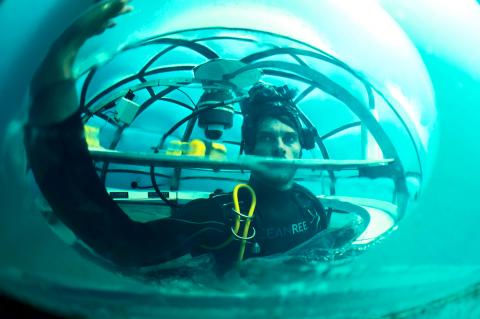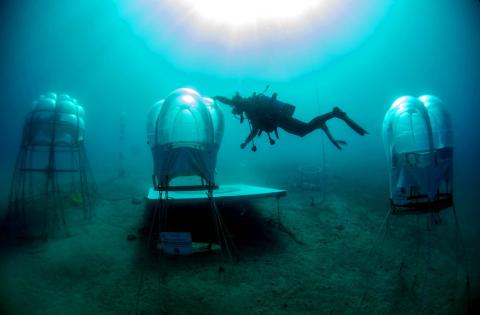In the homeland of pesto, a group of diving enthusiasts have come up with a way of growing basil beneath the sea that could revolutionize crop production in arid coastal areas around the world.
The pungent green herb has long been synonymous with the steep, terraced cliff-sides of Liguria, the northern Italian region known for its spectacular Riviera coastline and for producing one of the world’s best-loved pasta sauces.
Those two standout features of the region could now become even more intimately associated thanks to the pioneering efforts of Sergio Gamberini.

Photo: AFP
A diving nut and specialist in underwater communications, Gamberini has begun growing basil in large plastic spheres anchored to the sea bed 100m off shore and 8m below the surface in an experiment he has dubbed “Nemo’s Garden.”
“The idea came to me because I wanted to create more interaction between the surface and the diving activity,” Gamberini told AFPTV.
Having started with a simple plastic ball into which he placed a tub with herb seeds planted in compost, he is now in his fourth season of production from an underwater garden comprised of three “biospheres,” which he is allowed to keep in the water for three months a year.

Photo: AFP
“I chose a typical activity of farmers, and I said: ‘Why not bring it under water?’” he said. “I realized that there was an opportunity to create a new site to grow vegetables.”
Evaporation ensures humidity between 80 and 90 percent inside the spheres, the condensation provides the necessary moisture and, even well below the waves, there is enough light in that sunny corner of Europe to ensure the plants themselves regenerate their oxygen supply via photosynthesis.
Having proven the system works, Gamberini’s challenge now is to prove that it can produce herbs and vegetables in a cost-efficient way.
“I don’t know if it will be the future because we have to prove that it can be self-supportable,” he said. “If a pound of lettuce [grown underwater] costs too much, it won’t have a future.”
The primary advantage of underwater growing is the stability of thermal conditions.
“The sea maintains the temperature without a great difference between day and night,” said Gianni Fontanesi, who is in charge of running the project.
In late June, at the start of the European summer, the water on the coastal shelf of the northern Mediterranean is 25oC, while inside the spheres the temperature reaches 29oC.
The plants are thriving in an environment where they are protected from the insects and parasites that would normally be giving a basil grower headaches at this time of year.
The results so far have been encouraging, with the spheres producing more densely leafed plants than is usual — perfect for being ground up with pine nuts, parmesan and olive oil to produce authentic Ligurian pesto.
An experiment with lettuce is already underway and mushrooms, tomatoes and green beans will all be given a go this summer.
“In the longer term, this could be a solution for arid regions next to the sea,” said Gamberini, adding that there is still much work to be done to work out how to apply his principles on a larger scale.
However, he is not the only one to have faith in his idea: underwater basil was one of the 20 food-related innovations chosen to represent Italy at the ongoing World Expo in Milan, which has “Feeding the Planet, Energy for Life” as its theme.

The US dollar was trading at NT$29.7 at 10am today on the Taipei Foreign Exchange, as the New Taiwan dollar gained NT$1.364 from the previous close last week. The NT dollar continued to rise today, after surging 3.07 percent on Friday. After opening at NT$30.91, the NT dollar gained more than NT$1 in just 15 minutes, briefly passing the NT$30 mark. Before the US Department of the Treasury's semi-annual currency report came out, expectations that the NT dollar would keep rising were already building. The NT dollar on Friday closed at NT$31.064, up by NT$0.953 — a 3.07 percent single-day gain. Today,

‘SHORT TERM’: The local currency would likely remain strong in the near term, driven by anticipated US trade pressure, capital inflows and expectations of a US Fed rate cut The US dollar is expected to fall below NT$30 in the near term, as traders anticipate increased pressure from Washington for Taiwan to allow the New Taiwan dollar to appreciate, Cathay United Bank (國泰世華銀行) chief economist Lin Chi-chao (林啟超) said. Following a sharp drop in the greenback against the NT dollar on Friday, Lin told the Central News Agency that the local currency is likely to remain strong in the short term, driven in part by market psychology surrounding anticipated US policy pressure. On Friday, the US dollar fell NT$0.953, or 3.07 percent, closing at NT$31.064 — its lowest level since Jan.

The New Taiwan dollar and Taiwanese stocks surged on signs that trade tensions between the world’s top two economies might start easing and as US tech earnings boosted the outlook of the nation’s semiconductor exports. The NT dollar strengthened as much as 3.8 percent versus the US dollar to 30.815, the biggest intraday gain since January 2011, closing at NT$31.064. The benchmark TAIEX jumped 2.73 percent to outperform the region’s equity gauges. Outlook for global trade improved after China said it is assessing possible trade talks with the US, providing a boost for the nation’s currency and shares. As the NT dollar

The Financial Supervisory Commission (FSC) yesterday met with some of the nation’s largest insurance companies as a skyrocketing New Taiwan dollar piles pressure on their hundreds of billions of dollars in US bond investments. The commission has asked some life insurance firms, among the biggest Asian holders of US debt, to discuss how the rapidly strengthening NT dollar has impacted their operations, people familiar with the matter said. The meeting took place as the NT dollar jumped as much as 5 percent yesterday, its biggest intraday gain in more than three decades. The local currency surged as exporters rushed to